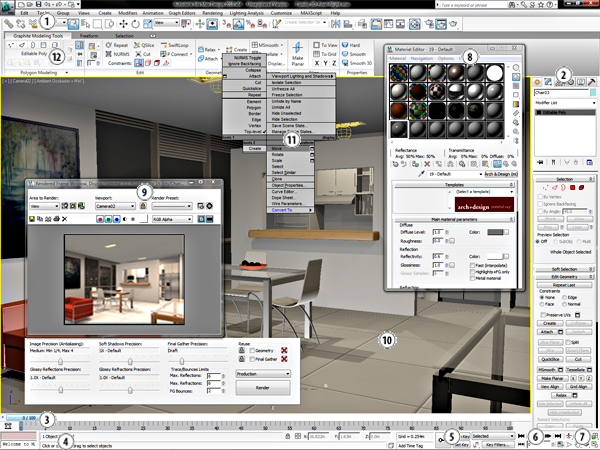 |
Main Toolbar |
| The main toolbar provides quick access to tools and dialogs for many of the most common tasks in 3ds Max
Design. |
 |
 |
Graphite Modeling Tools |
| Graphite Modeling Tools combines a wealth of new polygon-modeling features, including freeform sculpting and powerful loop-modeling tools, with the tried and true toolset in a dynamic, configurable new “ribbon” interface. |
 |
 |
Quad Menu |
| When you click the right mouse button anywhere in an active viewport, except on the viewport label, a quad menu is displayed. The options available in the quad menu depend on the selection. |
 |
 |
Viewport |
| When you start 3ds Max Design, the main screen contains a single viewport, although you can switch to displaying up to
four viewports showing the scene from different angles. You can set a viewport to show a simple wireframe or shaded view of the scene, and you can also employ advanced but easy-to-use Review features such as shadows (hard-edged or soft-edged), exposure control, and ambient occlusion to display highly realistic, near-rendered results in real time. |
| | |
 |
Command Panel |
| The command panel comprises six user-interface panels that give you access to most of the modeling features of 3ds Max
Design, as well as some animation features, display choices, and miscellaneous utilities.
To switch to a different panel, click its tab at the top of the command panel. |
|
 |
Time Slider |
| The time slider lets you navigate along the timeline and jump to any animation frame in your scene.
You can quickly set position and rotation or scale keys by right-clicking the time slider and choosing the desired key from the Create Key dialog. |
|
|
 |
Rendered Frame Window |
| The Rendered Frame Window displays a rendering of your scene. Press F9 to trigger the rendering process. Using Rendered Frame Window controls, you can change render presets, lock the rendering to a single viewport, render regions of the viewport for faster feedback, and change mental ray settings such as final gather and reflections without having to access other portions of the program. |
|
 |
Material Editor |
| The Material Editor, which you open with the M key, provides functions to create and edit materials and maps.
Materials are assigned to objects and create greater realism in a scene by using different maps. |
|
